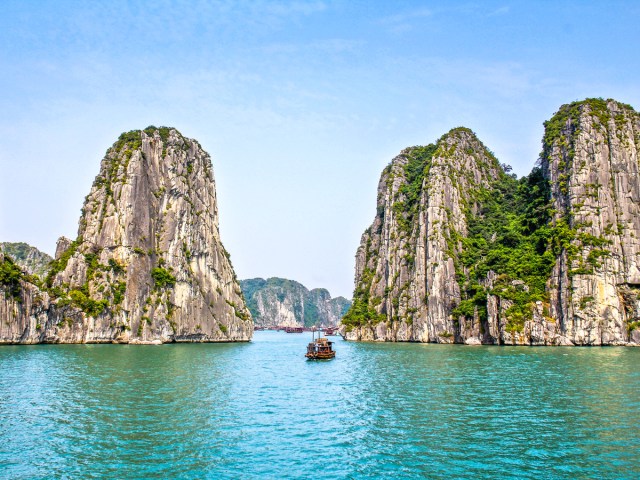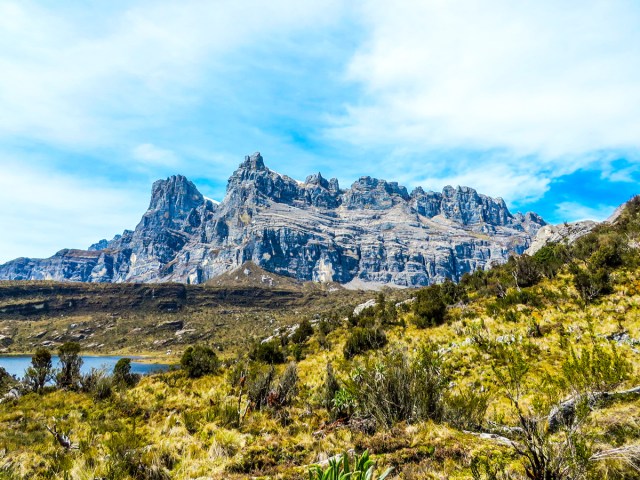While getting to Southeast Asia requires a long flight for U.S. travelers, many would say the payoff at the other end is well worth the journey. The region is home to some of the planet’s most epic scenery, both natural and human-made, from its largest-volume waterfall to its biggest religious complex and its tallest island peak. While narrowing down a list of places to visit in Southeast Asia is next to impossible, here are 10 beautiful sites to start.
Old Bagan – Myanmar

Golden pagodas rise above the mists of the Irrawaddy River valley in Myanmar’s mystical, mysterious Mandalay region, and nowhere in greater concentration than in the ancient city of Old Bagan. The seat of power for the Bagan Kingdom, the city reached its height between the 11th and 13th centuries, when its plains held more than 10,000 temples, stupas, and monasteries.
While Bagan has since survived wars and earthquakes, and some of its historic religious structures fell into disrepair, about 2,500 Buddhist temples remain — and many are considered among the world’s most beautiful. The city only recently became a UNESCO World Heritage Site in 2019, and so it remains relatively untouristed. But an increasing number of visitors from across the globe are drawn to this sacred landscape. A hot air balloon ride is the most iconic way to experience the magic, but bicycle tours, boat trips, and Jeep safaris also provide a glimpse into this fascinating region.
Halong Bay – Vietnam

Around 1,600 jagged, rainforest-covered limestone pillars erupt from the emerald waters of Ha Long Bay — creating one of Vietnam’s dreamiest landscapes. The full name of this UNESCO World Heritage Site, Vịnh Hạ Long, translates to “Where the Dragon Descends to the Sea,” an evocative way to describe this 600-square-mile bay in the South China Sea’s Gulf of Tonkin that has become one of the country’s must-see tourist destinations.
Once an ideal hideout for pirates, the karst monoliths were made famous in the 1997 James Bond film Tomorrow Never Dies. Like Scotland’s Loch Ness, Ha Long Bay has its own mythical monster, a camera-shy sea serpent known as the Tarasque, but that doesn’t stop the hordes of visitors flocking to see the bay’s caves and beaches, peruse the area’s pearl farms, cruise on classic sailing vessels (junks) or explore under their own steam via kayak. About a three-hour drive from Hanoi, Ha Long has a huge selection of lodging options, from basic guesthouses to five-star resorts, but many visitors choose to stay overnight on the bay.
Khone Phapheng Falls – Laos

Khone Phapheng Falls are found in southern Laos, near the border of Cambodia in the Champasak Province, but the river that forms it begins high on the Tibetan plateau. The mighty Mekong — which, at 2,703 miles in length, is Southeast Asia’s longest river — winds through Si Phan Don to create the Khone Phapheng Falls. These chocolate brown rapids stretch over 6.7 miles wide and fall at a rate of 2.5 million gallons per second — nearly double that of Niagara Falls. The falls contain the greatest volume of water of any waterfall on Earth, and the series of cataracts prevent the Mekong from being completely navigable into China.
One of the country’s most popular tourist attractions, Khone Falls are home to a visitors center with a temple, museum, and observation deck. The region surrounding the falls is easily explored by bicycle, or opt for a kayak tour on the Mekong and encounter rare Irrawaddy dolphins. Don’t miss the historic (and now defunct) bridge built by the French to connect Don Det and Don Khone islands, and — if you dare — take a thrilling zipline over Li Phi Falls.
Angkor Wat – Cambodia

Sprawling across more than 400 acres near the modern city of Siem Reap, Angkor Wat (“Temple City”) is the world’s largest religious structure — so big it’s visible to astronauts in space. Khmer Emperor Suryavarman II built this awe-inspiring temple complex in the 12th century for the Hindu god Vishnu (though it later became a Buddhist place of worship). It served as the capital of the Khmer empire for several centuries, its design an architectural nod to Mount Meru — the center of both the Hindu and Buddhist universes.
Five towers represent the peaks of the mountain, and the moat and defensive wall symbolize the surrounding oceans and mountain ranges. Millions of sandstone blocks from a quarry at Phnom Kulen, Cambodia’s most sacred mountain, were used in the temple’s construction — some weighing as much as 3,300 pounds. Though it’s no longer in use, Angkor Wat remains Cambodia’s most famous temple — so entwined in the country’s history that its image graces the national flag.
Palawan – The Philippines

The only province in the Philippines with two designated UNESCO World Heritage Sites, the slender island of Palawan immediately draws you in with its array of natural wonders. The island province is one of southeast Asia’s most biologically diverse regions — much of which can be seen in the coral reefs surrounding the uninhabited islands of Tubbataha Reefs Natural Park, one of Palawan’s two UNESCO sites. Located in the Sulu Sea, the park is home to some of the world’s best scuba diving. And if shipwrecks are more to your liking, the waters around Coron are littered with the remains of World War II-era Japanese ships.
The province’s other UNESCO Site is Puerto Princesa Subterranean River National Park. Above ground, it features a spectacular landscape of limestone karsts, but the star of the show is the park’s namesake: a vast subterranean waterway (one of the world’s longest) that flows beneath an enormous cave dome filled with river channels, rock formations, and nine species of bats.
Chiang Mai – Thailand

Most visitors flock to Thailand’s largest city, Bangkok, but they’d be missing out on the quieter wonders of the northern city of Chiang Mai, where there are more than 300 Buddhist temples to explore. Founded in 1296, Chiang Mai is the former capital of Lan Na, a kingdom that endured until the 16th century and promoted Buddhism’s Theravada tradition. In a nod to its history, Chiang Mai’s highly walkable Old City remains bordered by a moat and much of the original 700-year-old fortress wall.
Another reason to visit is Chiang Mai’s easy access to nature. The city is the capital of a province of the same name that is home to around 1.2 million people, as well as more than 50 national parks. That includes Doi Inthanon National Park, which brings together the namesake Himalayan peak (the tallest in Thailand at 8,415 feet) and one of the country’s most beautiful waterfalls, Mae Ya Waterfall. Post-monsoon season, when temperatures turn balmy between November and February, many visitors seek out Chiang Mai for its numerous Asian elephant sanctuaries.
Gardens by the Bay – Singapore

Singapore’s commitment to both futuristic technology and sustainability is on full display at the Gardens of the Bay, a stunning nature park built on 250 acres of reclaimed land. It’s part of a bid to transform this Southeast Asian city-state into a true “City in a Garden.” But this isn’t the urban garden you’re used to — here, the star of the show is a mechanical forest of 18 towering steel structures known as “Supertrees.”
Each soars an impressive 80 to 160 feet tall, with a trunk that forms a vertical garden covered in more than 158,000 plants. The Supertrees help nourish the plants by redistributing heat, collecting rainwater, and providing shade; many even collect solar power. A 400-foot-long aerial walkway winds between them, 75 feet above ground. Just make sure you don’t leave the gardens before sunset, when the Supertrees put on a dazzling, unforgettable light show against the backdrop of Singapore’s modern skyline.
Puncak Jaya – Indonesia

Rising 16,024 feet like a fin of sheer rock out of dense jungle, Puncak Jaya (formerly called Carstensz Pyramid) is the tallest peak on New Guinea and the tallest island peak in the world. Dutch explorer Jan Carstensz reported seeing glaciers on the peak in 1623 and was ridiculed by Europeans, who insisted snow could not exist so near the equator. His claim was not verified for more than 200 years, and Puncak Jaya remains one of the world’s few tropical or equatorial mountains to contain glaciers.
Although the lowest in elevation of mountaineering’s famed Seven Summits — the highest peak on each continent — Puncak Jaya, located in the remote Sudirman mountain range, is considered to be the most technically difficult to climb. The journey to base camp requires a four- or five-day hike through dense jungle, in often heavy rains, and the sheer descent calls for rappelling or abseiling. Still, that didn’t stop Austrian climber Heinrich Harrer and his team from finally reaching the summit on February 13, 1962 — nor the thrillseekers who have followed in their footsteps since.
Golden Bridge – Vietnam

One might say you’ll be in good hands as you walk across this 500-foot-long pedestrian bridge suspended high above the mystical landscapes of Vietnam’s Da Nang mountains. Cau Vang (which translates to “Golden Bridge”) winds across the verdant mountain scenery of the popular Ba Na Hills amusement park and resort, but its practical purpose — to connect a cable-car station with the resort’s picturesque gardens — isn’t what draws millions of eager tourists each year.
That would be the pair of giant weathered stone hands that hold the bridge in place, stretching upward toward the sky as if they were plucked out of a centuries-old fairy tale. Opened in 2018, the awe-inspiring bridge was designed, according to its architects, to mimic the “giant hands of Gods, pulling a strip of gold out of the land.” As part of a multibillion-dollar investment to bring more visitors to the amusement park, it appears to have done the trick — the attraction, seemingly tailor-made for the Instagram age, went viral almost as soon as it opened.
Phranang Cave Beach – Thailand

Krabi province, on southern Thailand’s Andaman Coast, is home to some of the country’s most remarkable scenery, and breathtaking Phranang Cave Beach — accessible only by boat — is a must when visiting the province. Visitors from around the world come to relax on the palm-filled sugar-sand beaches, snorkel in the emerald waters, kayak, climb the dramatic limestone outcroppings, and explore the honeycomb of caves that dot the coast. At the beach itself, longtail food boats bob at the shore, waiting to serve the spicy and flavorful cuisine for which Thailand is famed.
At the edge of the beach is a cave said to be the home of a mythical sea princess. Local fishermen have filled it with statues that represent Shiva, the Hindu god, and are intended to promote fertility and prosperity. But for the best panoramic views of the beach, climb to the overlook above the Railay peninsula — it’s especially spectacular at sunset.
More from our network
Daily Passport is part of Inbox Studio, which publishes content that uplifts, informs, and inspires.
















